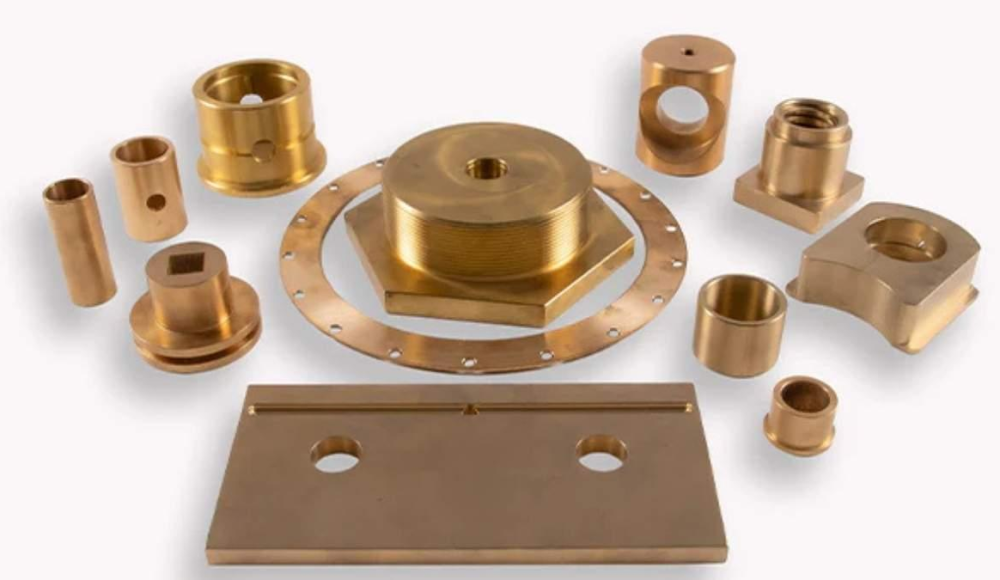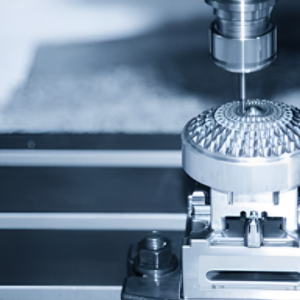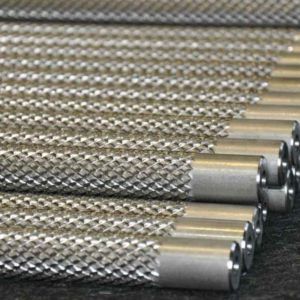La lega di bronzo comporta prestazioni incredibili. Questi sono spesso usati nelle maniglie delle porte e nelle medaglie, ma le loro applicazioni non finiscono qui. Inoltre, il bronzo è utilizzato nei componenti del motore, utensili, e pompe. Inoltre, è molto impiegato nelle campane e nelle fontane ornamentali delle navi.
Comprendere il Bronzo
Il metallo bronzo si trova solitamente in un colore bruno-rossastro appartenente al gruppo dei “metalli rossi”.. Contiene 88% rame e 12% stagno; è relativamente flessibile e ha molti usi industriali. Inoltre, la lega è più dura del rame puro, semplificando i processi produttivi. Il basso contatto metallo-metallo ne migliora l'applicabilità in diversi settori. A volte, ingredienti come il fosforo o lo zinco migliorano le caratteristiche del bronzo. Per fusione si intende la fusione del bronzo, l'aggiunta di altri materiali e il successivo raffreddamento in stampi per anime.
Tipi di metallo bronzo
Il bronzo circonda intorno 50 tipi di leghe distinti. Per brevità, ecco cinque varietà comuni nel settore manifatturiero:
| Tipo Bronzo | Composizione (Elementi aggiuntivi) |
| Bronzo alluminio | 6–12% alluminio |
| Bronzo Al Nichel-Alluminio | 6–13% alluminio, fino a 7% ferro, 7% nichel |
| Bronzo al silicio | Fino a 6% silicio |
| Bronzo fosforoso | Fino a 11% stagno, 0.35% fosforo |
| Bronzo al manganese | Fino a 3% manganese |
Proprietà fisiche del bronzo
Di seguito sono riportate le principali proprietà fisiche del bronzo:
| Proprietà | Descrizione |
| Densità (g/cc) | 5.60 – 9.30 |
| Colore | Marrone-rossastro metallizzato |
| Punto di fusione (°C) | 315 – 1180 |
| Punto di ebollizione (°C) | 1400 |
| Conduttività termica (W/m-K) | 1.01 – 208 |
Proprietà chimiche del bronzo
Il bronzo presenta diverse importanti caratteristiche chimiche:
| Proprietà | Descrizione |
| Resistenza alla corrosione | Bene |
| Conduttività elettrica | Bene |
| Prodotti di ossidazione | Ossido di rame, carbonato |
| Magnetico | NO |
| Malleabilità | Bene |
| Duttilità | Alto |
Leghe di bronzo comuni
Le comuni leghe di bronzo sono discusse di seguito:
Bronzo alluminio
Contiene bronzo all'alluminio alluminio in giro 9 A 14%. Ha un'alta resistenza, prodotto, resistenza all'abrasione, e caratteristiche meccaniche. Il bronzo all'alluminio è ottimale per le industrie marine perché è resistente all'acqua salata, e alcali. I prodotti includono eliche, valvole, e numerose altre parti della nave. Adatto anche per ingranaggi e cuscinetti. La forza è simile a 50-55 HRC di acciaio al carbonio medio.
Alcuni esempi generali di bronzo all'alluminio includono:
- C95400 (Bronzo alluminio)
- C95500 (Bronzo alluminio al piombo)
- C95800 (Bronzo di alluminio ad alta resistenza)
- C95900 (Bronzo di alluminio con nichel)
Bronzo Al Nichel-Alluminio
L'alluminio al nichel presenta le proprietà del nichel e dell'alluminio. Questa lega offre eccellenti prestazioni di corrosione in ambienti distinti. Tuttavia, la resistenza alla vaiolatura è superiore a quella del 300 serie di acciaio inossidabile. Oltretutto, è adatto per applicazioni marine e aerospaziali. La flessibilità del bronzo al nichel Ni-Al è uno dei principali punti di forza, in particolare nella saldatura.
Alcuni esempi generali di bronzo al nichel-alluminio includono:
- C95400 (Bronzo Al Nichel-Alluminio)
- C95500 (Bronzo alluminio nichel piombo)
- C95800 (Bronzo alluminio nichel ad alta resistenza)
- C95900 (Bronzo al nichel-alluminio con manganese)
Bronzo allo stagno
Il bronzo allo stagno è un'antica lega di bronzo, solitamente caratterizzato da discrete caratteristiche di fusione e anticorrosive. Ha tutto lo stagno 12% quindi utilizzato per ingranaggi e cuscinetti. Tuttavia, l'aggiunta del bronzo allo stagno al progetto di lavorazione può aumentare il costo totale del materiale da utilizzare nella fabbricazione di prodotti elettronici.
Alcuni esempi generali di bronzo allo stagno includono:
- C90200 (Bronzo allo stagno)
- C90300 (Bronzo allo stagno piombato)
- C90500 (Bronzo ad alto contenuto di stagno)
- C90700 (Alluminio-Stagno Bronzo)
Bronzo al manganese
Il bronzo al manganese è altamente resistente alla corrosione dell'acqua di mare, con il raggiungimento della massima resistenza alla trazione 110,000 PSI. Gli usi abituali sono nei cuscinetti, ingranaggi, ed eliche utilizzate nelle navi marine.
Alcuni esempi generali di bronzo al manganese includono:
- C86300 (Ciao Trazione)
- C86400 (Manganese piombo)
- C86500 (Bassa resistenza)
- C86200 (Med trazione)
Cuscinetto di bronzo
I bronzi allo stagno ad alto contenuto di piombo vengono impiegati nei cuscinetti e nelle boccole. Le leghe sopra menzionate sono relativamente economiche ed efficienti in termini di funzionalità. L'LCR è legato al contenuto di stagno. La distribuzione del piombo migliora la forza, lubrificazione, e conformabilità. Il bronzo dei cuscinetti può funzionare a 450 ° F / 230°C. La sua capacità di carico è di circa 4,000 PSI.
Alcuni esempi generali di cuscinetti in bronzo includono:
- C93200 (Bronzo allo stagno)
- C93700 (Bronzo allo stagno piombato)
- C94300 (Bronzo alluminio)
- C90500 (Bronzo ad alto contenuto di stagno)
Bronzo contro. Ottone: Differenze chiave
Bronzo e ottone si distinguono principalmente in base alla loro costituzione e proprietà. Entrambi sono leghe di rame e non si corrodono facilmente. Tuttavia, il bronzo sviluppa uno strato di ossido sulla sua superficie man mano che invecchia. D'altra parte, è noto che l'ottone ha la caratteristica di ossidarsi lentamente.
L'ottone è una lega contenente rame, zinco, e alcuni altri ingredienti. Questi aspetti determinano il colore di questo tipo di metallo che può essere un oro lucido oppure un argento. L'ottone può essere modellato più facilmente del bronzo, quindi è più duttile. Questa proprietà rende l'ottone abbastanza resistente da poter essere martellato e laminato senza rompersi.
Processo di produzione del bronzo
Il bronzo è stato importante per secoli nello sviluppo di strumenti e armi. Il processo di produzione del materiale è complesso ma semplice. Questa lega rigida viene preparata riscaldando lo stagno e il rame puro una volta raggiunto il punto di fusione. I gas miscelati devono poi essere raffreddati e raffinati e la miscela fusa deve essere versata in stampi di argilla e lasciata raffreddare.. Di seguito sono riportati i principali processi di produzione relativi al bronzo:
Lavorabilità al bronzo
La lavorazione del bronzo per cuscinetti può produrre buoni risultati se eseguita in modo efficace. Durante la lavorazione di progetti, l'uso di liquido refrigerante o lubrificante migliora la qualità superficiale del prodotto finito. Perché nonostante abbia una grande robustezza, i rischi vanno presi con attenzione durante le operazioni. Per esempio, si consigliano velocità inferiori durante l'alesaggio a causa della “presa”.
Resistenza alla corrosione del bronzo
Il bronzo ha un incredibile livello di corrosione, e può essere utilizzato in condizioni in cui altri metalli non possono sopravvivere, come nell'acqua salata. Ha una finitura unica che può essere lucidata fino a renderla lucida o mantenuta per produrre un oggetto unico, aspetto leggermente simile alla ruggine.
Ricottura del bronzo
Il bronzo non è facile da ricotturare e alleviare lo stress. COSÌ, la ricottura del bronzo deve essere eseguita con attenzione attraverso il riscaldamento. È fondamentale mantenere la temperatura per un'ora per pollice di spessore della parete a 260 C. Non può essere fatto a un ritmo veloce, altrimenti potrebbe crollare, e frattura. Lavorazione del bronzo al silicio che ha una maggiore percentuale di piombo, richiede particolare cautela, e dovrebbero essere osservate le misure necessarie come indossare indumenti protettivi adeguati e le corrette metodologie di estrazione.
Fusione in bronzo
La fusione del bronzo è stata utilizzata per secoli per produrre capolavori dal metallo fuso. Ciò include la realizzazione di strumenti musicali, sculture, premi, ecc. che utilizzano processi come la cera persa, conchiglie in ceramica, o sabbia. Gli artigiani seguono un processo delicato e utilizzano diverse tecniche per versare il bronzo fuso negli stampi per creare notevoli opere d'arte.
Formabilità e duttilità
Come la maggior parte dei metalli, il bronzo può anche essere formato a basse temperature per migliorarne la resistenza e la rigidità. Le proprietà di basso attrito del bronzo per cuscinetti lo rendono adatto all'uso in numerose applicazioni. Ad esempio, il bronzo della campana produce suoni risonanti, e molte delle altre leghe di bronzo mostrano un'eccellente resistenza alla corrosione da parte dell'acqua di mare.
Soprattutto, il bronzo è duttile, ed è possibile trafilarlo in fili sottili senza che si rompa. Questa caratteristica è particolarmente utile nei generatori di tutto il mondo che dimostrano le capacità del metallo.
Vantaggi del bronzo
- La resistenza è superiore alla purezza del rame o del ferro.
- Un ottimo livello di resistenza alla corrosione ne migliora la durata.
- Conduttività termica ed elettrica più elevata rispetto alla maggior parte dei tipi di acciaio.
- La resistenza alla fatica sembra essere superiore a quella di molte leghe.
- La fusione è più elevata, quindi la fusione è più semplice.
- È anche importante dire che il basso attrito metallo-metallo è un vantaggio nelle applicazioni meccaniche.
- Usabilità a tutto tondo, ed efficienza nelle molteplici applicazioni per le quali viene utilizzato.
- Fornisce un rivestimento superficiale di alta qualità.
Svantaggi del Bronzo
- Il bronzo è più soggetto all'ossidazione rispetto alla sua lega, ottone.
- A volte è anche più costoso dell'acciaio, ottone, o rame.
- Il composto è suscettibile al deterioramento da parte dei composti ferrici e dell'ammoniaca.
- I danni da zolfo e cloro possono essere accelerati da circostanze umide.
- Può svilupparsi la malattia del bronzo, evidenziato da macchie verde chiaro sulla pelle.
- Se questa condizione non viene affrontata porta a un grave deterioramento.
Conclusione
Per riassumere, il bronzo merita di essere definito uno scaglione di tipi di leghe inventivi e resistenti. Ha una gamma di proprietà meccaniche desiderabili e resistenza alla corrosione. Anche se ha i suoi demeriti, che includono costi elevati e sensibilità a determinate condizioni ambientali, i vantaggi che derivano dall'implementazione di questo approccio sono più vantaggiosi. Infine, diventa chiaro che il bronzo rimane un materiale essenziale nella produzione, un chiaro indicatore della sua rilevanza. Contattaci per maggiori informazioni.




1 pensato a “Tutto sul metallo bronzeo”